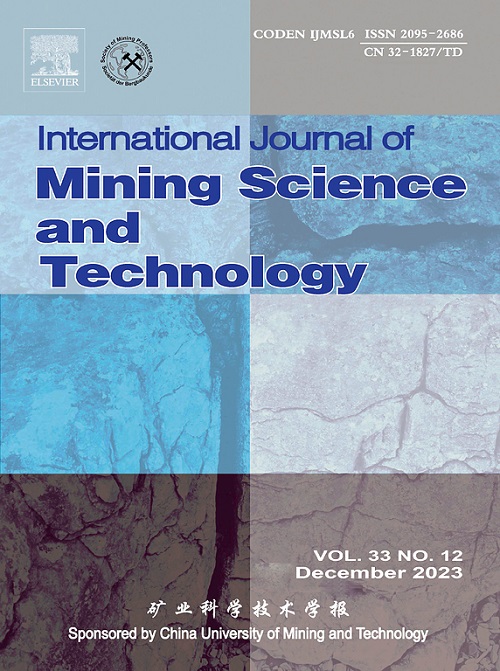A statistical damage-based constitutive model for shearing of rock joints in brittle drop mode
IF 11.7
1区 工程技术
Q1 MINING & MINERAL PROCESSING
International Journal of Mining Science and Technology
Pub Date : 2024-08-01
DOI:10.1016/j.ijmst.2024.08.007
引用次数: 0
Abstract
Some rock joints exhibit significant brittleness, characterized by a sharp decrease in shear stress upon reaching the peak strength. However, existing models often fail to accurately represent this behavior and are encumbered by numerous parameters lacking clear mechanical significance. This study presents a new statistical damage constitutive model rooted in both damage mechanics and statistics, containing only three model parameters. The proposed model encompasses all stages of joint shearing, including the compaction stage, linear stage, plastic yielding stage, drop stage, strain softening stage, and residual strength stage. To derive the analytical expression of the constitutive model, three boundary conditions are introduced. Experimental data from both natural and artificial rock joints is utilized to validate the model, resulting in average absolute relative errors ranging from 3% to 8%. Moreover, a comparative analysis with established models illustrates that the proposed model captures stress drop and post-peak strain softening more effectively, with model parameters possessing clearer mechanical interpretations. Furthermore, parameter analysis is conducted to investigate the impacts of model parameters on the curves and unveil the relationship between these parameters and the mechanical properties of rock joints. Importantly, the proposed model is straightforward in form, and all model parameters can be obtained from direct shear tests, thus facilitating the utilization in numerical simulations.
基于统计损伤的脆性落差模式岩石节理剪切构造模型
一些岩石节理表现出明显的脆性,其特点是达到峰值强度后剪应力急剧下降。然而,现有的模型往往不能准确地表示这种行为,而且被众多缺乏明确力学意义的参数所束缚。本研究提出了一种植根于损伤力学和统计学的新型统计损伤构成模型,仅包含三个模型参数。提出的模型涵盖了连接剪切的所有阶段,包括压实阶段、线性阶段、塑性屈服阶段、下降阶段、应变软化阶段和残余强度阶段。为了推导出构成模型的解析表达式,引入了三个边界条件。利用天然和人工岩石节理的实验数据对模型进行了验证,结果发现平均绝对相对误差在 3% 到 8% 之间。此外,与已有模型的对比分析表明,所提出的模型能更有效地捕捉应力下降和峰值后应变软化,模型参数具有更清晰的力学解释。此外,还进行了参数分析,以研究模型参数对曲线的影响,并揭示这些参数与岩石节理力学性能之间的关系。重要的是,所提出的模型形式简单明了,所有模型参数均可从直接剪切试验中获得,因此便于在数值模拟中使用。
本文章由计算机程序翻译,如有差异,请以英文原文为准。
求助全文
约1分钟内获得全文
求助全文
来源期刊

International Journal of Mining Science and Technology
Earth and Planetary Sciences-Geotechnical Engineering and Engineering Geology
CiteScore
19.10
自引率
11.90%
发文量
2541
审稿时长
44 days
期刊介绍:
The International Journal of Mining Science and Technology, founded in 1990 as the Journal of China University of Mining and Technology, is a monthly English-language journal. It publishes original research papers and high-quality reviews that explore the latest advancements in theories, methodologies, and applications within the realm of mining sciences and technologies. The journal serves as an international exchange forum for readers and authors worldwide involved in mining sciences and technologies. All papers undergo a peer-review process and meticulous editing by specialists and authorities, with the entire submission-to-publication process conducted electronically.
 求助内容:
求助内容: 应助结果提醒方式:
应助结果提醒方式:


